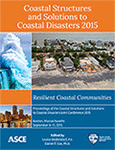Coastal Structures and Solutions to Coastal Disasters Joint Conference 2015
Laboratory Modelling of Scour on Seawalls
Publication: Coastal Structures and Solutions to Coastal Disasters 2015: Resilient Coastal Communities
ABSTRACT
This paper presents the results of an experimental investigation performed to understand the occurrence of scour in front of a vertical seawall. A single wave steepened by an artificial slope that breaks on the seawall or as close as possible to it was generated. For this purpose, a physical model was constructed and placed in a 2D wave flume where a focused wave group was generated at the toe of the fore slope. Three distinctive sediment types for the slope were tested (sand and two gravel sizes) and the experimental program included tests with different slope angles, relative submergence, still water depths and energy spectra (Jonswap and Top-Hat). Empirical models for the prediction of scour as a function of the maximum wave height at toe of the slope were obtained for the sand and smallest gravel slopes.
Get full access to this article
View all available purchase options and get full access to this chapter.
REFERENCES
CIRIA Manual (2013). “Physical processes and tools for levee assessment and design.” Series no. C731.
Coastal Construction Manual (2005). “Principles and practices planning, siting, designing, constructing and maintaining buildings in coastal areas.” Vol. III, FEMA.
Fredsøe, J. and Sumer, B. M. (1997). “Scour at the head of a vertical-wall breakwater.” Coastal Engineering, Vol. 29, pp. 201-230.
Fowler, J. E. (1992). “Scour problems and methods for prediction of maximum scour at vertical seawalls.” Army Corps of Engineers, Waterways Experiment Station, Technical Rep. No. CERC-92-16, U.S. Vicksburg, Miss.
Herbich, J. B. and Ko, S. C. (1968). “Scour of sand beaches in front of seawalls.” Coastal Engineering, No. 11, Chapter 40.
Ichikawa, T. (1967). “Scouring damages at vertical wall breakwaters of Tagonoura Port.” Coastal Engineering in Japan, Vol. 10, pp. 95-108.
Jayaratne, R., Hunt-Raby, A., Bullock, G., and Bredmose, H. (2008). “Individual violent overtopping events: New insights.” 31st International Conference on Coastal Engineering, ASCE, Hamburgo, Vol. IV, pp. 2983-2995.
Jayaratne, R., Abimbola A., Mikami T., Matsuba S., et al. (2014). “Predictive model for scour depth of coastal structure failures due to tsunamis.” ICCE, No. 34, Structures (56).
Mase, H., Tamada, T., Yasuda, T., Karunarathna, H., & Reeve, D. E. (2015). “Analysis of Climate Change Effects on Seawall Reliability.” Coastal Engineering Journal, Vol. 57.
McDougal, W.G., Kraus, N. and Ajiwibowo, H. (1996). “The effects of seawalls on the beach: Part 2 Numerical modeling of SUPERTANK seawalls tests.” J. Coastal Reseach, Vol. 12, pp. 702-713.
Pagliara, S., and Palermo, M. (2013). “The analysis of scour characteristics in the presence of aerated crossing jets.” Australian Journal of Water Resources, Vol. 16, Issue 2, pp. 163-172.
Powell, K. A. (1987). “Toe scour at sea walls subject to wave action.” Hydraulics Research Wallingford, Report no. SR119.
Sato, S., Tanaka, N. and Irie, I. (1968). “Study on scouring at the foot of coastal structures.” 11th ICCE, London, England, Chapter 37, pp. 579-598.
Shore Protection Manual (1984). US Army Engineers, Waterways Experiment Station, Coastal Engineering Research Center, US Government Printing Office, Washington, DC, Vol. II.
Smith, E. R. (1996). “Potential toe scour and wave reflection at revetments.” US Army Corps of Engineers, Waterways Experiment Station, Miscellaneous paper CERC-96-2.
Sumer, B. M., et al. (2001). “Scour around coastal structures: A summary of recent reserch.” Coastal Engineering, Vol. 44, pp. 153-190.
Sutherland, J., Obhrai, C., Whitehouse, R. J. S. and Pearce, A. M. C. (2014). “Laboratory test of scour at a seawall.” Proceedings of the Third International Conference on Scour and Erosion, Gouda, The Netherlands, CURNET, Technical University of Denmark.
Tsai, C. P., Chen, H. B. and You, S. S. (2009). “Toe scour of seawall on a steep seabed by breaking waves.” Journal of Waterway, Port, Coastal, Ocean and Engineering, ASCE, Vol. 135, pp. 61-68.
Twu, S. W. and Liao, W. M. (1999). “Effects of seawall slopes on scour depth.” Journal of Coastal Research, Vol. 15, pp. 985-990.
Van Rijn, L. C. (2013). “Local scour near structures.” Taken from:
Walton, T. L. and Sensabaugh, W. (1979). “Sea-wall design on the open coast.” Florida Sea Grant College, Report No. 29, p. 24.
Information & Authors
Information
Published In
Coastal Structures and Solutions to Coastal Disasters 2015: Resilient Coastal Communities
Pages: 809 - 816
Editors: Louise Wallendorf, U.S. Naval Academy and Daniel T. Cox, Ph.D., Oregon State University
ISBN (Online): 978-0-7844-8030-4
Copyright
© 2017 American Society of Civil Engineers.
History
Published online: Jul 11, 2017
Published in print: Jul 11, 2017
Authors
Metrics & Citations
Metrics
Citations
Download citation
If you have the appropriate software installed, you can download article citation data to the citation manager of your choice. Simply select your manager software from the list below and click Download.
